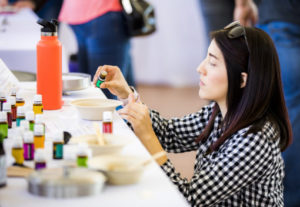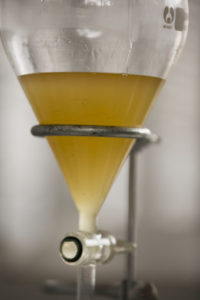
Are you ready to craft your very own customized essential oil blends?
So lets get started!
I’m going to walk you through a simple process for you to create customized aromatic and therapeutic essential oil blends. Creating Signature Scents, personal gifts, specific problem-solutions… learning how to create your own essential oil blends will allow you to do all that!
9 Steps To Blending Essential Oils
1. Begin by determining What You Want
To being able to create the perfect blend, you first need to ask yourself the six famous questions:
- Who is this essential oil blend for?
- What effect do I want it to have?
- When will it be used?
- Where will it be used?
- How will it be applied?
- Why is this blend needed?
Are you a morning grouch and maybe need an energizing blend for yourself so you can start your mornings feeling more awake, energized, and uplifted? Or do you need an oil blend which can help your child find a better and sounder sleep?
Anything you need – anything you can think of… there are always essential oils there, ready to help you with it.
2. Essential Oil Properties: which oils should i pick?
Once you’ve answered the above questions, it’s time to hit the books or the World Wide Web and do some essential oil research. The goal of this second step is to come up with a list of essential oils that have the properties you’re looking for in your blend.
Mae this is a crude list… a rough draft of sorts. You will not be using all of the essential oils you put on this list, its just the selection you will later pick your essential oils from. So just go ahead and gather lots of ideas and information in this step. The basic idea is to come up with some 10-20 essential oils to get you started, and as you progress through the steps for blending essential oils, you can simplify this big list later in the process.So for example, if you’re looking for an energizing blend, research 10 to 20 energizing essential oils and put them on your list.
3. Evaluating Your Essential Oils
Now you created your list based on
- their therapeutic actions
- or you’ve chosen oils based on their scent.
You might even have chosen your essential oils with both of the above in mind. In any way, you now got a list of essential oils which match your goal. After evaluating your list on suitability, availability and possibly price, we come to the next step: which essential oils like blending together and which don’t?
4. Essential Oil Categories: Who likes whom?
To make the perfect blend, it’s important to make sure you find essential oil combinations that go together or attract so they smell nice once they’re blended together. So in this step we’re about to figure out, which essential oil belongs to which category. Essential oils are grouped together in so called categories based on their aromas.
Essential Oil Categories examples:
- Citrus – Orange, Bergamot, Lemon, Lime, Tangerine, Jade Lemon
- Earthy – Vetiver, Patchouli, Myrrh, Ginger, Carrot Seed
- Floral – Lavender, Neroli, Jasmine, Ylang Ylang, Chamomile
- Herby – Marjoram, Clary Sage, Basil, Oregano, Thyme
- Medicinal – Eucalyptus, Rosemary, Tea Tree, Hyssop
- Minty – Peppermint, Spearmint
- Spicy –Nutmeg, Clove, Cinnamon, Black Pepper
- Woodsy –Pine, Fir, Spruce, Cedar, Cypress, Frankincense, Sandalwood, Wintergreen
- and so on…
Now find out which category each of the essential oil on your list belong to and mark them. There are different ways of how to find out wich category an essential oil falls into. The easiest step would be to buy yourself a book where you can find this kind of information, or look for a category list online.
Something you always need to remember is; there is no actual “wrong” and “rite” when dealing with essential oils. Information can sometimes vary from site to site and book to book, and you may need to check in more than one place. Different people make different experiences with essential oils, so depending on your source you might get different information than somebody else. Now thats where you come in: make your own experiences and learn from them. The more experience you get, the more you learn to understand essential oils, the easier it will become for you to spot fake information from the truth.
Now find out which category your essential oils belong to, and make a note to which category blends well with which category. Just as categorizing essential oils is subjective, so is combining categories. So go ahead and follow your nose. Ultimately, there are no absolutes when it comes to blending essential oils. That’s the art of essential oil blending! It’s totally based on your preferences and how the oil smells to you.
Now with that being said, there are a few guidelines which can help you:
- Essential oils from the same category tend to combine well together.
- Essential oils in one category can also be mixed and matched with other complementary categories, this makes it interesting 🙂
Here are a view suggestions on which categories blend well together:
- Citrus blends with citrus, floral, woodsy, minty, and spicy
- Woodsy blends with woodsy, floral, earthy, herby, minty, medicinal, spicy, and citrus
- Earthy blends with earthy, woodsy, and minty
- Herbaceous blends with herby, woodsy, and minty
- Spicy blends with spicy, floral, woodsy, and citrus
- Floral blends with floral, woodsy, spicy, and citrus
- Minty blends with minty, woodsy, earthy, herby, and citrus
- Medicinal blends with medicinal and woodsy
Now go back to your list and chart out which oils will go together. Follow your knowledge of what you have learned so far, and follow your gut and feeling. When dealing with essential oils, they help us to get back our access to our gut feelings and instincts. Once you’ve gone through all possible category combinations and you have these written out, it’s time to move on to the next step where we’ll add some balance to the essential oils on your list.

5. Essential Oil Notes: Bringing Balance into your blend
Have you ever applied a blend of oils to your skin and noticed how it smells right away only to find that 3 hours later it smells a bit different than when you first put it on? This is because one or more of the notes in your blend have evaporated.
By paying attention to the notes of your essential oils, you can bring balance and harmony into your blend. Essential oil notes are referred to as top notes, middle notes, and base notes. The “note” of an essential oil is determined by how quickly the scent of the essential oil fades after being exposed to oxygen.
Essential Oil Notes:
- Top notes are the lightest of the all the notes. They’re the first ones you smell, and they’re the first ones to evaporate. This is because they have the smallest molecules. You can often distinguish top note essential oils because they’re often thin in consistency and are usually derived from flowers, leaves, and flowering herbs.
- Base notes are are deep, heavy, and often earthy in scent. These are the oils that ground your blend and help its aroma last the longest due to the large molecule size. Base notes are often derived from trees, roots, and barks, and their oils tend to be thick and viscous.
- Middle notes are like the “ties that bind” only they are binding your other essential oils together into a harmonized blend. These are the oils that complete your blend by balancing the light top notes with the deep base notes. The aroma of middle notes lasts longer than those of top notes, but not as long as base notes. These oils can vary in consistency and are often derived from whole herbs and spices.
(Natural Perfumery Basics, n.d.; Bovenizer, n.d.)
You can look to books with essential oil profiles or online websites of essential oil suppliers for information on notes. And just like essential oil categories, the information you find on essential oils notes will vary. Some essential oils have one note while others are thought to have a combination of two with one of the two being more dominant than the other. The more experience you are going to have with your oils, the easier it will get for you to identify the correct information, you will even learn to smell for yourself 🙂
Now that you have identified the notes for each oil in her potential blends, it’s time to create some combinations. When it comes to blending essential oils, it’s recommended to start with three essential oils in a blend until you’re familiar and comfortable with the blending process. Start by identifying the notes for each of the oil on your list. Then go ahead and write down 3 essential oils from categories that combine well together (every combination should contain a top, middle and base note oil). If you want you can do this with a few essential oils on your list, just to test.

6. Ready, Set, Go: Gathering Your Blending Supplies
Yeay! Almost there. We are nearing the end of the steps for blending essential oils. The hard work is over and now comes the fun part – blending.
Now go and gather your blending supplies together so you can get to work. What do you need?
- Your essential oils
- Empty bottles to put your blend in
- Labels
- Depending on whether you’re creating a spray, perfume, massage oil or just a pure essential oil blend have your jar ready
- You need a carrier oil?
Purchasing Essential Oils
Where should I buy my essential oils? This is probably the most difficult and at the same time most important question. Depending on where you buy your essential oils, price can vary a lot.
But like everywhere in life: you don’t get high quality for little money, not possible. It all boils down to what are you, what is your health worth to you? Cheap oils can be very toxic and harmful on your health. For me personally, I only let the essential oils of Young Living, and sometimes of a small farmer I personally meet near me. I want to be sure my essential oils are 100% pure and not adulterated with petrochemicals and other hazardous ingredients (yes, unfortunately most oils do contain these stuff, even if their label doesn’t tell).
The rule I go by is: never put something on your skin, you wouldn’t eat.
High quality essential oils can be quite expensive. So go ahead and make yourself an own spray or dilute them with a high quality carrier oil. But please don’t harm yourself in buying cheap and harmful essential oils.
7. Essential Oil Blending Ratios: A littel bit of this, a little bit of that
So how to find out how much to use of each essential oil? Again, there is no right and wrong here either, but some guidelines which can help you.
Essential Oil Blending Rules:
- The 30-50-20 Rule
- The Perfect Balance
- Bottoms Up
The 30-50-20 Rule teaches us to put 30% of the top note oil, 50% of the middle note oil and 20% of the base oil in our essential oil blend. So if you go with 10 total drops, you have 3 drops of the top note oil, 5 drops of the middle note oil and 2 drops of the base note oil. This blending ration helps us to finde a harmonious distribution of the essential oil notes – especially helpful when blending oils from different categories.
The Perfect Balance method tells us to take the same amount of every essential oil. This works best if you combine oils from the same category. So if you chose 3 oils for example, you would take 5 drops each.
Bottoms Up is creative and gives us lots of freedom in our choices. It works exactly how it sounds: you start with your base notes, followed by your heart notes and finally your
This last blending ratio is a fun one, and it’s the closest you’ll get to intermediate or advanced blending so I’ve saved it for last. I call it “Bottoms Up” because it’s exactly as it sounds. You’re going to turn your blend over and build it from the bottom up, starting with the base note, then the middle note, then the top note.
This blending ratio doesn’t have a drop limit, but keep in mind that you want your blend to stay small so you don’t waste your oils (in case you don’t like it). You’ll be keeping track of your essential oils and drops on paper. This blending ratio works well with pure combinations (essential oils from one category) and mixed combinations (essential oils from complementary categories).
Here’s how it works.
You’re going to start off by combining one drop of each base and middle note oils, swirl and smell your blend, then add another drop or two of whichever oil (base or middle note) you like best. Don’t forget to keep track of everything on paper, including your thoughts on the aroma of your blend (see the “on taking notes” section below).
Once you’ve got your base and middle note oils smelling the way you want them, you’ll add in one drop of your top note oil, swirl and smell your blend again, and see what you think. From there, you keep adding oils one drop at a time until you get the a scent you like. Like I said, this blending ratio is a mix between beginner and intermediate blending because you’re only working with three essential oils, but you’re relying on your senses and intuition to guide you.






